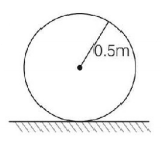Question
A uniform circular disc of radius $$50\,cm$$ at rest is free to turn about an axis which is perpendicular to its plane and passes through its centre. It is subjected to a torque which produces a constant angular acceleration of $$2.0\,rad\,{s^{ - 2}}.$$ Its net acceleration in $$m{s^{ - 2}}$$ at the end of $$2.0\,s$$ is a approximately
A.
7.0
B.
6.0
C.
3.0
D.
8.0
Answer :
8.0
Solution :
According to given question, a uniform circular disc of radius $$50\,cm$$ at rest is free to turn about an axis having perpendicular to its plane and passes through its centre. This situation can be shown by the figure given below :

$$\eqalign{ & \therefore {\text{Angular}}\,{\text{acceleration,}}\,\alpha = 2\,rad\,{s^{ - 2}}\,\,\left( {{\text{given}}} \right) \cr & {\text{Angular}}\,{\text{speed,}}\,\omega = \alpha t = 4\,rad\,{s^{ - 1}} \cr & \because {\text{Centripetal}}\,{\text{acceleration,}}\,{a_c} = {\omega ^2}r = {\left( 4 \right)^2} \times 0.5 \cr & = 16 \times 0.5 \cr & {a_c} = 8\;m/{s^2} \cr} $$
$$\because $$ Linear acceleration at the end of $$2\,s,$$
$$\eqalign{ & {a_t} = \alpha r = 2 \times 0.5 \cr & \Rightarrow {a_t} = 1\;m/{s^2} \cr} $$
Therefore, the net acceleration at the end of $$2.0\,s$$ is given by
$$\eqalign{ & a = \sqrt {a_c^2 + a_t^2} \cr & a = \sqrt {{{\left( 8 \right)}^2} + {{\left( 1 \right)}^2}} = \sqrt {65} \cr & \Rightarrow a \approx 8\;m/{s^2} \cr} $$
According to given question, a uniform circular disc of radius $$50\,cm$$ at rest is free to turn about an axis having perpendicular to its plane and passes through its centre. This situation can be shown by the figure given below :

$$\eqalign{ & \therefore {\text{Angular}}\,{\text{acceleration,}}\,\alpha = 2\,rad\,{s^{ - 2}}\,\,\left( {{\text{given}}} \right) \cr & {\text{Angular}}\,{\text{speed,}}\,\omega = \alpha t = 4\,rad\,{s^{ - 1}} \cr & \because {\text{Centripetal}}\,{\text{acceleration,}}\,{a_c} = {\omega ^2}r = {\left( 4 \right)^2} \times 0.5 \cr & = 16 \times 0.5 \cr & {a_c} = 8\;m/{s^2} \cr} $$
$$\because $$ Linear acceleration at the end of $$2\,s,$$
$$\eqalign{ & {a_t} = \alpha r = 2 \times 0.5 \cr & \Rightarrow {a_t} = 1\;m/{s^2} \cr} $$
Therefore, the net acceleration at the end of $$2.0\,s$$ is given by
$$\eqalign{ & a = \sqrt {a_c^2 + a_t^2} \cr & a = \sqrt {{{\left( 8 \right)}^2} + {{\left( 1 \right)}^2}} = \sqrt {65} \cr & \Rightarrow a \approx 8\;m/{s^2} \cr} $$





